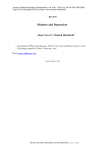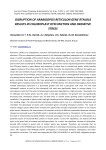Статьи журнала - Журнал стресс-физиологии и биохимии
Все статьи: 984

Determining legume plants that tolerate dryness and grow in dry lateritic soil
Статья научная
In arid regions, productivity is restricted by an abundance of water. The objective of the research is to screen of suitability of some legume plants in the dry laterite soil of Purulia and adjoining districts in West Bengal, India. Seedlings (25 days old) of Acacia mangium Willd., Albizia procera (Roxb.) Benth, Bauhinia acuminata Linn. of the family Leguminosae (Fabaceae) is subject to PEG- induced water stress (- 0.5 and -1.0 MPa) to assess their relative water content and the contents of chlorophyll, protein, soluble sugars and proline in leaves as well as activities of enzymes catalase, peroxidase and superoxide dismutase (SOD). In leaves of the seedlings, chlorophyll and protein contents decline with increasing levels of PEG-induced water stress in the case of all species whereas the amount of soluble sugar and proline content increases in all species with increasing levels of water stress. The enzyme activity of catalase, peroxidase and SOD decreased with increased level of water stress. Such decline in the activity of these enzymes was least in B. acuminata . Apparently, B. acuminata is potentially most tolerant to water stress among the plants studied.
Бесплатно
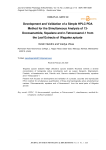
Статья научная
Wagatea spicata (Dalzell) Wight [Moullava spicata (Dalzell) Nicolson] exhibits a diverse concentration of biologically active constituents such as Lupeol, Bergenin, Stigmasterol, Friedelin, n-Hexadecanoic acid, Palmitic acid, Gamma sitosterol,13docosenamide, squalene and n-Tetracosanol-1. Present work focuses on development and validation of a precise, accurate and reproducible HPLC method for simultaneous quantification of three pharmacologically active phytochemical markers 13docosenamide, squalene and n-Tetracosanol-1 from the aerial parts of Wagatea spicata.
Бесплатно
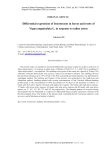
Статья научная
The present study was intended to reveal the differential isoesterase expression in leaves and roots of Vigna unguiculata L. in response to saline stress. Influence of NaCl (0, 3, 5, 7 and10 %) on seedlings of Vigna unguiculata L. was analyzed. The seedlings were grown in the centre for a period of 30 days. The randomly collected whole plants were used as a source for isoesterase isolation. The seedlings showed the maximum tolerance up to 10% of NaCl. The Poly acrylamide gel electrophoresis was performed by Anbalagan method. The staining and fixation of the enzyme was performed by the Sadasivam and Manickam method. Seedlings treated with various concentrations of NaCl showed different banding profile based on the concentration (0-10%) and duration (5-30 days) of salt treatment as follows: 32 bands with five active regions, 56 bands with eight active regions, 102 bands with eight active regions, 47 bands with seven active regions, 64 bands with nine active regions and 84 bands with nine active regions on 5th, 10th, 15th, 20th, 25th and 30th day respectively. The changing pattern of isozymes during development may be interpreted as evidence for differential timing of gene expression correlated with the physiological stress. The results of the present study concluded that the isoesterase patterns could serve as a useful biochemical marker of salinity.
Бесплатно
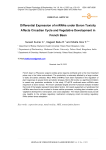
Статья научная
French bean is ( Phaseolus vulgaris ) widely grown legume worldwide and is the most important pulse crop in the Indian subcontinent. The productivity is adversely affected by a large number of biotic and abiotic stresses. Micro RNAs (miRNAs) have been implicated in the regulation of plant responses to several biotic and abiotic stresses. Boron (B) toxicity is a significant limitation to cereal crop production worldwide. In this study, RT-qPCR confirmed seven miRNAs were responsive to boron toxicity. The known predicted targets and their functional analysis revealed that most of the targets represent transcription factors. GO results supported our hypothesis that miRNAs were found to be involved in diverse cellular processes, including plant circadian cycle, vegetative development, transcription, and cross adaptation. The results obtained would provide new insights to the complex regulatory mechanism employing small non-coding regulatory RNAs toward stress adaptation.
Бесплатно
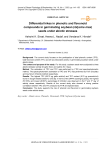
Статья научная
Background: The current study focuses on the participation of total phenolic content (TPC), total flavonoid content (TFC) as well as antioxidant activity in germinating soybean seeds under abiotic stress. The context and purpose of the study: For this study, soybean seeds were subjected to three abiotic stresses namely drought, flood, and salinity for 3 days. Method: The estimation of TPC and TFC was performed by FTIR and spectrophotometric method. The spectrophotometric estimation of TPC and TFC was performed by Folin Ciocalteu and Aluminium Chloride method respectively. Results: The highest TPC (68.78 µg gallic acid/ml) and TFC content (6.23 µg quercetin/ml) found in drought treated seeds for one day. In terms of the DPPH scavenging assay, the highest (67.63%) and lowest (46.83%) percentage of inhibition was observed on the1st and 3rd day of salinity stress respectively. Results of the current study also showed a strong positive correlation between TPC and TFC analyzed by FTIR and Spectral data. Conclusion: The study supports the role of phenolic and flavonoid in germinating soybean seeds under abiotic stress.
Бесплатно
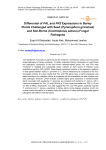
Статья научная
The seedborne Pyrenophora graminea and the soilborne Cochliobolus sativus are economical fungal pathogens of barley worldwide. To better understand barley mechanisms to resist these two pathogens, expression of two well known defense-related genes PAL and PR2 were monitored in resistant and susceptible barley cultivars at early points of infection using quantitative real-time PCR (qPCR). Data showed significant variance in the expression patterns of both genes between barley P. graminea or C. sativus interactions as compared to the non-inoculated controls. It is also notable that PAL and PR2 genes have a higher expression and faster induction in the resistant cultivar as compared with the susceptible one after infection with each pathogen. However, qPCR analysis revealed higher gene expression in resistant barley plants inoculated with seedborne P. graminea as compared with soilborne C. sativus , with a maximum expression for PAL (15 and 6.8-fold) at 72 hours post inoculation and PR2 (13.2 and 5.3-fold) at 96hpi, respectively. Our data suggest that PAL and PR2 genes , positively regulate P. graminea and C. sativus-resistance in barley plants during disease progress, which can provide useful information for a deeper molecular research on barley defense responses against pathogens with different infection styles.
Бесплатно
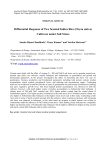
Differential response of two scented indica rice (Oryza sativa) cultivars under salt stress
Статья научная
Present report deals with the effect of varying (0 - 200 mM NaCl) salt stress on two popular scented non-basmati type indica rice cultivars, namely Indrayani and Ambemohar on germination and growth and biochemical parameters. In the present investigation the effect of increasing salt stress was seen on germination, biomass production and biochemical parameters including total protein content, proline accumulation, starch content, polyphenols levels, and reducing and non-reducing sugars. Contrasting behavior was evidenced in both the cultivars in terms of germination rate and biomass production at seedling and early vegetative growth level. Salt stress-induced proline accumulation was observed in both the cultivars, however, with much higher extent of proline accumulation in Ambemohar than Indrayani. A salinity stress of 200 mM NaCl resulted into 305% higher proline content than the control plants of Ambemohar against 222% higher proline in Indrayani at the same stress level. Similarly protein content was also higher in Ambemohar than Indrayani at the highest stress level used in this study. Contrasting results were seen in terms of starch content amongst both the cultivars, where continuous decrease with increasing salt stress was observed in Indrayani, on the other hand, an increase in starch content was evident in Ambemohar under the influence of NaCl-induced salt stress. These finding clearly indicates the comparably higher salt tolerant nature of Ambemohar than Indrayani which might be attributed to higher proline, protein and starch content than Indrayani cultivar under salt stress.
Бесплатно
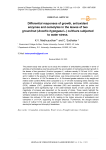
Статья научная
The present study was carried out to study the variation of antioxidative potentials in terms of activities of antioxidative enzymes along with the accumulation of osmolytes and plant growth in the leaves of two groundnut ( Arachis hypogaea L.) cultivars namely K-134 and JL-24 under three levels of water supply conditions. Growth retardation in terms of root and shoot length, and in relation to the severity of drought stress was more pronounced in susceptible cv. JL-24 than in in tolerant cv. K-134.The leaves of cv. JL-24 showed greater reduction in dry weight and relative water content (RWC) when compared to cv. K-134 with increasing stress intensity. The activities of antioxidative enzymes which include superoxide dismutase (SOD), peroxidase (POX), catalase (CAT), glutathione reductase (GR) and osmolytes such as proline and glycinebetaine were significantly high in the water-stressed leaves of both cultivars and the magnitude of increase was dependent on the severity of stress. These results highlight the ability of groundnut cultivars to up-regulate the enzymatic antioxidant system and osmolytes to withstand oxidative during water deficit conditions. However, the extent of up-regulation varied between the cultivars K-134 and JL-24, leading to the higher amounts of antioxidants and osmolytes in cv.K-134, supporting its drought tolerance. Furthermore, the drought tolerant nature of cultivar K-134 was well supported by lower rates of membrane lipid peroxidation, electrolytic leakage and chlorophyll breakdown.
Бесплатно
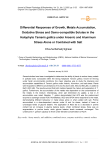
Статья научная
Several studies have been investigated to determine the ability of plants to reduce heavy metals in polluted soils. Conducted within the strong halophyte Tamarix gallica , known for thriving under harsh environmental conditions, the major objective was to study the tolerance and accumulation capabilities of Tamarix gallica under Arsenic, Aluminium, and salt stress. Plants were exposed to different concentrations of Al and As alone (200, 500 and 800 µM), or added to NaCl (200 mM). The results evinced that both metals impaired the mature and expanation of T. gallica . Furthermore, the accumulation of the metals was dependent on the concentrations of the metals in the medium. Interestingly, when salt diminished As uptake, a rise in Al accumulation was noted. Besides, T. gallica demonstrated that APX was the predominant enzyme to scavenge excess ROS. Nonetheless, SOD and GPOX were responsive to the metal, demonstrating different behaviour in metal stress alone or when added with salt. Proline accumulated in a dose-dependent manner under Al and As stress, instead of lower or unchanged levels of glycine betaine. The application of NaCl led to a decrease in proline content but an increase in glycine betaine levels. Under combined stress, there was an augmentation in proline levels, while glycine betaine levels remained unchanged. This underscores T. gallica 's capacity to thrive under elevated concentrations of As/Al.
Бесплатно
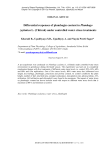
Статья научная
A pot experiment was conducted on Plumbago zeylanica L. (Chitrak) under controlled water stress environment in greenhouse during the kharif season. The experiment was laid out in completely randomized design with five treatments of different water stress levels i.e. control, 20%, 40%, 60% and 80% and four replications. Out of five stress levels, 80% water stress has influenced root length, dry herbage, plumbagin, potassium and proline content. In control conditions the plant height, number of leaf, total leaf area, stomatal conductance, transpiration rate, photosynthesis, CO2 utilization, H2O utilization and chlorophyll were found to be maximum. The impact of water stress on plumbagin content has shown increase trend with respect to different water stress levels that is maximum at 80 % and minimum at control.
Бесплатно
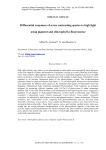
Статья научная
High light intensity may induce severe photodamage to chloroplast and consequently cause decreases in the yield capacity of plants and destruction of pigments, causing an overall yellowing of the foliage. Thus, study related to light adaptation becomes necessary to understand adaptation processes in higher plants on the basis of which they are characterized as full sunlight or shade plants. Chlorophyll can be regarded as an intrinsic fluorescent probe of the photosynthetic system. The ecophysiological parameter related to plant performance and fitness i.e. in-situ chlorophyll fluorescence measurements were determined for different plant species in the medicinal plant garden of Banasthali University, Rajasthan. Miniaturized Pulse Amplitude Modulated Photosynthetic Yield Analyzers are primarily designed for measuring effective quantum yield (ΔF/Fm') of photosystem II under momentary ambient light in the field. Photosynthetic yield measurements and light-response curves suggested a gradation of sun-adapted to shade-adapted behaviour of these plants in following order Withania somnifera> Catharanthus roseus> Datura stamonium> Vasica minora> Vasica adulta> Rauwolfia serpentina. As indicated by light response curves and pigment analysis, Datura stramonium, Withania somnifera and Catharanthus roseus competed well photosynthetically and are favoured while Rauwolfia serpentina, Vasica minora, Vasica adulta and Plumbago zeylanica were observed to be less competent photosynthetically. These light response curves and resultant cardinal points study gave insight into the ecophysiological characterization of the photosynthetic capacity of the plant and provides highly interesting parameters like electron transport rate, photo-inhibition, photosynthetically active photon flux density and yield on the basis of which light adaptability was screened for seven medicinally important plants.
Бесплатно
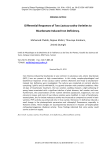
Differential responses of two lactuca sativa varieties to bicarbonate-induced iron deficiency
Статья научная
Iron chlorosis induced by bicarbonate is very common in calcareous soils, where bicarbonate (HCO 3-) ions are present at high concentrations. In this study, morpho-physiological and biochemical responses of two Lactuca sativa varieties (Romaine and Vista) to bicarbonate-induced iron deficiency were investigated. The culture was conducted on nutrient solution containing 5 µM Fe and 10 mM NaHCO 3, in a growth chamber with controlled conditions. After 14 days of bicarbonate treatment, the two varieties seedling showed a slight yellowing of young leaves associated with a significant decline of plant biomass, leaf number and area. Furthermore, the concentrations of the nutrient elements (potassium, magnesium, iron and calcium) in leaves and roots of two lettuce varieties were modified. In roots of bicarbonate-treated plants, the Fe-chelate reductase activity was increased as compared to control in both varieties. PEPC activity was enhanced only in Vista variety. Moreover, Fe deficiency induced a small change in the photosynthetic parameters and chlorophyll fluorescence, especially in Romaine variety. These changes are accompanied by decreases in ribulose 1.5-bisphosphate carboxylase/oxygenase (Rubisco) activity. These findings indicated that vista variety could survive at low iron supply.
Бесплатно

Distal radial artery dimensions in different body constitutions (prakriti)- an observational study
Статья научная
Background: The fundamental principle of ayurveda is the tridosha theory ( three doshas) . These dosha are the causative and governing bio-energies responsible for the formation of body constitution. The vata dosha dominant personality have classical features like a small body frame when compared to kapha with large body built and broad anatomical structures. Pittaja body constitution has medium body built with reddish colouration and sharp features. Aim: This study aimed to correlate the radial artery intima-media thickness (IMT) and luminal diameter (LD) and further study its association with different body constitution ( prakriti ) and check the difference between the groups of prakriti . Methods: This observational cross-sectional study was done between May 2021 and June 2021 in the Department of Radiology, KLE Prabhakar Kore Charitable Hospital, Belagavi. Non-randomly selected volunteers ≥23 ±5years (n = 35) were divided into body constitution ( prakriti ) groups and evaluated for the IMT, LD (luminal diameter) of the radial artery using B-mode ultrasonography. Pearson’s co-relation was used to test the co-relation between the luminal diameter and intimae media thickness of distal radial artery. Chi-square test of independence was used to check the association between luminal diameter and intimae media thickness of distal radial artery with body constitution. One-way ANOVA was used to study the difference between the groups of prakriti . Results: The mean luminal diameter (LD) in vataja body constitution (5%) was 1.450 ± 0.495 mm, pittaja body constitution (11%) was 1.750±0.10 mm, kaphaja constitution (11%) was 1.70± 0.30 mm, vatapittaja body constitution (11%) was 4.15±0.47 mm, vatakaphaja body constitution (26%) was 1.64±0.83 mm, pittakaphaja constitution (23%) as 2.3±0.15 mm and samadhatuja constitution (11%) had 1.8±0.189 mm. The mean intima media thickness (IMT) in vataja body constitution (5%) was 0.05± 0 mm, pittaja body constitution (11%) was 0.03±0 mm, kaphaja constitution (11%) was 0.05± 0.014 mm, vatapittaja body constitution (11%) was 0.107±0.09 mm, vatakaphaja body constitution (26%) was 0.83±0.07 mm, pittakaphaja constitution (23%) was 0.313±0.006 mm and samadhatuja constitution (11%) had 0.350 ± 0.012 mm. As per the analysis a low positive Pearson’s correlation was found between IMT and LD (r = 0.254) between the luminal diameter (LD) and intima medial thickness (IMT) of distal radial artery. Chi square test of independence has shown significant association between DRA dimensions (IMT, LD) and body constitution ( prakriti) , palpatory blood vessel consistency. Among the observed values the v atakaphaja body constitution (0.83±0.07 mm) had increased intima media thickness (IMT). Among all the observed values the vatapittaja body constitution had broadest DRA luminal diameter (LD) of 4.15±0.47mm. One way ANOVA showed no significant difference between the groups of prakiti and IMT, LD of distal radial artery. Conclusion: As per the observations of the present study different body constitution (prakriti ) did not show any significant impact on distal radial artery dimensions (IMT and LD) as there are various factors like hormones, neural, blood volume regulators involved in vascular constriction and dilation. The prakriti assessment is a strong marker for prediction and the early diagnosis of diseases. This body constitution ( prakriti ) of an individual is the basic constituent on which the pulse wave variability of distal radial artery (DRA) acts.
Бесплатно
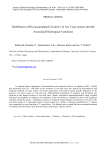
Статья научная
In nutrient culture experiments, bioaccumulation and anatomical effects of cadmium (CdCl2 - 20μM) and chromium (K2Cr2O7 - 600 μM) on the structure of root and stem was studied by histochemical and analytical methods in Vigna radiata and Vigna unguiculata. Each metal exerted specific influences on the anatomy of various tissues in root and stem. Histochemical localisation of cadmium and chromium was observed in the stained sections of root and stem. Atomic Absorption Spectrophotometric study revealed maximum accumulation of cadmium and chromium in the root tissue as compared to shoot with significant variation among the species. Abundant occurrences of densely stained deposits of chromium were seen in the root stelar region of V. unguiculata and to a lesser extend in V. radiata. Cadmium accumulation in V. radiata was comparatively more than that of V. unguiculata. The findings also revealed that the accumulation pattern of cadmium and chromium varies between species and hence is species specific.
Бесплатно
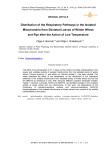
Статья научная
The effect of low temperature (2 ºС, 7 days) on the content of soluble carbohydrates in the leaves and oxidative activity of isolated mitochondria from the etiolated plants of winter wheat ( Triticum aestivum L.) and winter rye ( Secale cereale L.) has been studied. This paper describes the effect of low temperature on the distribution of the respiratory pathways in the isolated mitochondria from etiolated leaves of winter wheat and rye that are different by resistance to cold. With using the different oxidation substrates (malate, malate + rotenone, succinate, NADH and NADPH), we identified changes in the oxidative activity of winter wheat and rye mitochondria. In this work, the dependence of the functioning of cyanide-insensitive oxidase and rotenone-insensitive NAD(P)H dehydrogenases in the isolated mitochondria of winter cereals from content of the soluble carbohydrates is discussed.
Бесплатно
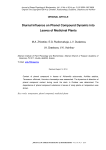
Diurnal influence on phenol compound dynamic into leaves of medicinal plants
Статья научная
Content of phenol compound in leaves of Alchemilla subcrenata, Achillea asiatica, Taraxacum officinale, Veronica chamaedrys was researched. The dynamics of alteration of phenol compound content during round the clock in October was determined. The dependence of phenol compound substance in leaves of study plants on temperature was shown.
Бесплатно
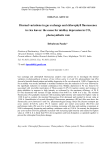
Статья научная
Gas exchange and chlorophyll fluorescence analysis were carried out to investigate the diurnal variations in photosynthesis in leaves of rice (Oryza sativaL.). Leaf CO2photosynthetic rate (Pn) showed a bimodal diurnal pattern and midday depression in Pn was observed at 13:00 h. Depression in Pn at midday was mostly attributed to stomatal limitation since the reduction in Pn was followed by the significant reduction in stomatal conductance (Gs). Midday depression in Pn was found to be associated with reversible inactivation of Photo-system II (PS II) reaction centers and increase of photo-inhibition in response to high intensity as evidenced by the maximum efficiency of PS II (Fv/Fm) decreased with increase of light intensity from 6:00 h to 16:00 h of a day. The minimal fluorescence (Fo) gradually increased with increasing light intensity and reached its highest value at 13:00 h and on contrary the maximal fluorescence (Fm) decreased and reached its lowest value at 13:00 h. Quantification of several chlorophyll fluorescence parameters (JIP-test) like area above the fluorescence curve between Fo and Fm, phenomenological energy fluxes like electron transport per cross section (ETo/CS), active PS II reaction center per exited cross-section (RC/CSo) and performance index (Pi) were low in early morning, increasing with time and reaching a maximum at 9:00 h subsequently decreasing and reaching a minimum value at 13.00 h. On contrary the dissipation per cross-section (Dio/CS) gradually increased with increasing light intensity and reached its highest value at 13:00 h. It is likely that PS II down-regulation and heat dissipation co-operated together to prevent the chloroplast from photo damage.
Бесплатно

Статья научная
From the ecological and economic point of view Agropyron elongatum, among perennial grasses, has a special place. This study was conducted to determine the most appropriate seed priming treatment and whether after a temporary stress removal, primed seeds have a higher recovery efficiency compared with unprimed seeds? In this research, seed was treated with different osmo and hydro priming and evaluated their effect by conducting germination test under drought stress (-1.2 and -1.4 MPa PEG) and recovery test. Hydro-primed seeds at 10 °C at all times (12, 24, 36 and 48 h) during priming; most indices of germination significantly improved compared to unprimed seeds. Also, seeds treated with osmopriming at both temperatures (10 & 15 °C) and all times of priming compared to unprimed seeds in the stress level of -1.2 MPa, the germination characteristics were improved. However, by increasing the potential of stress, few priming treatments have been able to maintain their superiority. It appears that priming can partially be effective on stress resistance and if the stress threshold is slightly higher than expected (this threshold for the Agropyron seeds in this study was -1.2 MPa) cannot have a noticeable effect on resistance to drought stress and can even be harmful too. All treatments which were placed in stressful situations and then moved to fresh water, showed a variety of recovery responses. As we viewed, primed seeds with a solution of -0.6 MPa urea for 12 h at 15 °C and followed by PEG solutions (-1.2 and -1.4 MPa) for 5 days and subsequently moved to fresh water conditions, had higher performance compared to unprimed seeds (P
Бесплатно

